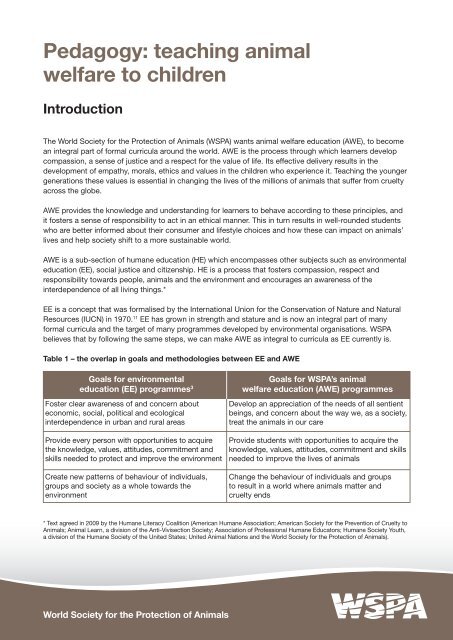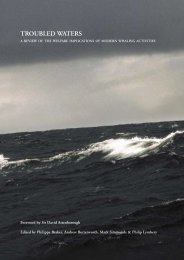WSPA - First Concepts: for teachers
WSPA - First Concepts: for teachers
WSPA - First Concepts: for teachers
You also want an ePaper? Increase the reach of your titles
YUMPU automatically turns print PDFs into web optimized ePapers that Google loves.
Pedagogy: teaching animalwelfare to childrenIntroductionThe World Society <strong>for</strong> the Protection of Animals (<strong>WSPA</strong>) wants animal welfare education (AWE), to becomean integral part of <strong>for</strong>mal curricula around the world. AWE is the process through which learners developcompassion, a sense of justice and a respect <strong>for</strong> the value of life. Its effective delivery results in thedevelopment of empathy, morals, ethics and values in the children who experience it. Teaching the youngergenerations these values is essential in changing the lives of the millions of animals that suffer from crueltyacross the globe.AWE provides the knowledge and understanding <strong>for</strong> learners to behave according to these principles, andit fosters a sense of responsibility to act in an ethical manner. This in turn results in well-rounded studentswho are better in<strong>for</strong>med about their consumer and lifestyle choices and how these can impact on animals’lives and help society shift to a more sustainable world.AWE is a sub-section of humane education (HE) which encompasses other subjects such as environmentaleducation (EE), social justice and citizenship. HE is a process that fosters compassion, respect andresponsibility towards people, animals and the environment and encourages an awareness of theinterdependence of all living things.*EE is a concept that was <strong>for</strong>malised by the International Union <strong>for</strong> the Conservation of Nature and NaturalResources (IUCN) in 1970. 11 EE has grown in strength and stature and is now an integral part of many<strong>for</strong>mal curricula and the target of many programmes developed by environmental organisations. <strong>WSPA</strong>believes that by following the same steps, we can make AWE as integral to curricula as EE currently is.Table 1 – the overlap in goals and methodologies between EE and AWEGoals <strong>for</strong> environmentaleducation (EE) programmes 3Foster clear awareness of and concern abouteconomic, social, political and ecologicalinterdependence in urban and rural areasProvide every person with opportunities to acquirethe knowledge, values, attitudes, commitment andskills needed to protect and improve the environmentCreate new patterns of behaviour of individuals,groups and society as a whole towards theenvironmentGoals <strong>for</strong> <strong>WSPA</strong>’s animalwelfare education (AWE) programmesDevelop an appreciation of the needs of all sentientbeings, and concern about the way we, as a society,treat the animals in our careProvide students with opportunities to acquire theknowledge, values, attitudes, commitment and skillsneeded to improve the lives of animalsChange the behaviour of individuals and groupsto result in a world where animals matter andcruelty ends* Text agreed in 2009 by the Humane Literacy Coalition (American Humane Association; American Society <strong>for</strong> the Prevention of Cruelty toAnimals; Animal Learn, a division of the Anti-Vivisection Society; Association of Professional Humane Educators; Humane Society Youth,a division of the Humane Society of the United States; United Animal Nations and the World Society <strong>for</strong> the Protection of Animals).World Society <strong>for</strong> the Protection of Animals
















